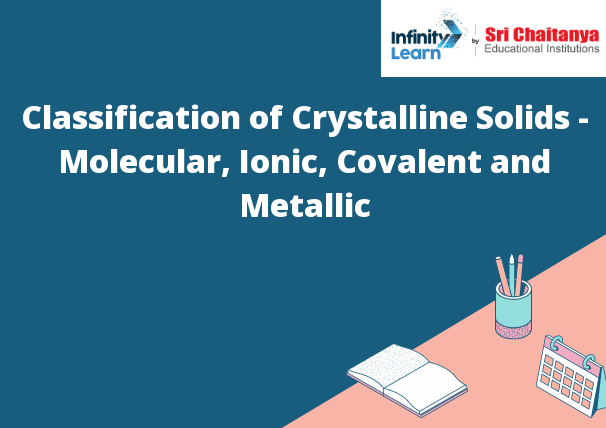Table of Contents
Crystalline Solids:
Crystalline solids are those that have an atomic or molecular structure that is ordered and periodic. This ordering results in the formation of a crystal lattice, in which the atoms are arranged in a specific and repeating pattern. There are six classes of crystalline solids, based on the type of crystal lattice that is formed. Classification of Crystalline Solids – Molecular Ionic Covalent and Metallic. These classes are:
1) Cubic crystals – These crystals have a three-dimensional lattice, in which the atoms are arranged in a cubic pattern. The most common example of a cubic crystal is ice.
2) Tetragonal crystals – These crystals have a four-sided lattice, with the atoms arranged in a square pattern. The most common example of a tetragonal crystal is quartz.
3) Orthorhombic crystals – These crystals have a three-dimensional lattice, with the atoms arranged in an orthorhombic pattern. The most common example of an orthorhombic crystal is calcite.
4) Monoclinic crystals – These crystals have a two-dimensional lattice, with the atoms arranged in a monoclinic pattern. The most common example of a monoclinic crystal is gypsum.
5) Hexagonal crystals – These crystals have a six-sided lattice, with the atoms arranged in a hexagonal pattern. The most common example of a hexagonal crystal is graphite.

Properties of Crystalline Solids
The defining characteristic of a crystalline solid is that its constituent atoms, molecules, or ions are arranged in a repeating, three-dimensional pattern. This regularity gives crystals their characteristic sparkle and hardness. The precise nature of the repeating pattern depends on the type of crystal.
Crystals are typically transparent or translucent, meaning that light can pass through them but they do not scatter it in all directions as a gas or liquid would. This is because the atoms, molecules, or ions in a crystal are densely packed and orderly. Some crystals, such as quartz, can also generate an electric field when they are rubbed. This is because the electric charges on the constituent atoms are lined up in the same direction.
Classification of Crystalline Solids
Crystalline solids are fascinating materials with a highly ordered and repetitive arrangement of atoms, ions, or molecules. They exhibit a wide range of properties and find applications in various fields, including materials science, electronics, and pharmaceuticals. In this article, we will delve into the classification of crystalline solids and explore the characteristics of each class.
- Ionic Solids: Ionic solids are formed by the attraction between positively and negatively charged ions. The ions are arranged in a three-dimensional lattice structure. These solids tend to have high melting points and are brittle in nature. Examples of ionic solids include common table salt (NaCl) and calcium carbonate (CaCO3).
- Molecular Solids: Molecular solids consist of individual molecules held together by intermolecular forces such as van der Waals forces or hydrogen bonding. The molecules are arranged in a regular pattern, forming a solid structure. Molecular solids generally have lower melting points compared to ionic solids. Examples include solid water (ice) and organic compounds like sucrose (table sugar) and naphthalene (mothballs).
- Covalent Network Solids: Covalent network solids are characterized by a vast network of covalent bonds, where each atom is bonded to several neighboring atoms. This results in a three-dimensional network structure. Covalent network solids have exceptionally high melting points due to the strong covalent bonds present throughout the structure. Diamond and graphite are prime examples of covalent network solids. While diamond is extremely hard and transparent, graphite is soft and conducts electricity due to its layered structure.
- Metallic Solids: Metallic solids are composed of a closely packed arrangement of metal atoms held together by metallic bonds. Metallic bonding allows for the free movement of valence electrons throughout the solid, giving rise to high electrical and thermal conductivity. Metallic solids often possess high melting points and exhibit malleability and ductility. Common examples include copper, aluminum, and iron.
Conclusion: The classification of crystalline solids provides insight into the diverse structures and properties exhibited by these materials. Ionic solids are held together by electrostatic forces between ions, molecular solids are formed by weak intermolecular forces, covalent network solids feature extensive covalent bonds, and metallic solids showcase a sea of delocalized electrons. Understanding the classifications helps scientists and engineers design and manipulate materials for specific applications, ranging from electronics and construction to pharmaceuticals and energy storage. By exploring the unique characteristics of crystalline solids, we continue to unlock new possibilities in the world of materials science.




